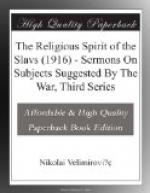THE POLISH REVOLUTION.
Mickiewicz, Sienkiewicz! Two great milestones in the history of the Polish soul; two great milestones in Christian history also! Both Roman Catholics and both revolutionists in religion. The religious revolution they made can be characterised only by the words “noble catholicity.” Both of them were attracted by Primitive Christianity much more than by the official Church of their own time. Sienkiewicz’s work “Quo Vadis?” is by far better known than Mickiewicz’s lectures on “The Official Church and Messianism.” Yet the same religious ideal has been pictured in both these works. Mickiewicz put on record as the true Christian men of suffering, of intuition and of action ("hommes de douleur, d’intuition, d’action"). Sienkiewicz described the first Christians as being such men. He revived the first days of Christianity in Rome. What striking contrasts between paganism and Christianity! Two quite different worlds in conflict—one world consisting of men of pleasure, and the other of men of suffering. On one side: Nero, Petronius, Vinicius, Seneca himself, and a mass harassed only about panem et circenses. On the other side: Paul of Tarsus, Petrus, Lygie, Ursus and many others willing to suffer and to die, and singing in suffering and in dying: pro Christo! pro Christo! On the one side, the proud Roman citizens, who adored force and who gave sacrifices to good and to evil spirits equally in order to save or procure their miserable, fleeting pleasure. On the other the humble inhabitants of the suburbs of Rome who adored only the Good Spirit of the Universe and did not care about pleasure, but about Justice and Love. Nero or Christ! The Emperor of the Casa Aurea, who, oversaturated and annoyed by life, finished by suicide; or the Prophet from Nazareth who came to establish the Kingdom of God on earth and who was forcibly crucified by the adorers of darkness!




